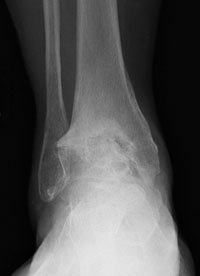Total ankle replacement shown to improve gait mechanics
KEYSTONE, Colo. — Gait mechanics improved in patients from preoperatively to 1 year and 2 years after total ankle replacement, according to a study presented by Robin M. Queen, PhD, at the 2011 Annual Meeting of the American Orthopaedic Foot and Ankle Society.
“We see a lot of total ankle replacement (TAR) patients at Duke and one of the questions that the surgeons have had for a long time is what is the rate of recovery following TAR and when these patients are able to complete simple functional tasks and how do they look when they are walking,” Queen said.
Another question Queen and her colleagues sought to answer was whether patients were happy with their surgery, which tends to influence clinical outcomes, she said.
Queen and colleagues won the Leonard J. Goldner Award at the meeting for their work.
Queen and her team studied 51 patients from a larger database who underwent TAR. Exclusion criteria were no previous TAR or ankle arthrodesis, no TAR scheduled for the contralateral side and no rheumatoid arthritis.
|
|
Images: Queen RM |
Queen and colleagues used a motion capture system and four force plates to compile 3-D joint mechanics and ground reaction forces (GRF). They collected gait mechanics data preoperatively and again at 1 year and 2 years postoperatively. Outcomes were measured using a repeated measures ANOVA to find any “significant differences between time points,” according to the study abstract.
Significant differences
Patients improved significantly in surgical side single-leg support time, double-leg support time, stride length, stride width, walking speed, peak anterior GRF and peak posterior GRF from preoperatively to 1 year postoperatively and from 1 year to 2 years postoperatively. Some measurements improved only between the preoperative and 1 year postoperative time points, including surgical-side stance time, step length, peak vGRF and peak plantar flexion moment.
“None of the measurements we looked at showed a decline in function from 1 year to 2 years,” Queen said.
No changes
Preoperative to 1 year or 2 years postoperatively, ankle angle at heel strike and peak dorsiflexion angle during the stance phase showed no changes.
“I was surprised by the ankle angle,” Queen said. “But when talking to the surgeons about this, their main goal in the surgery was to relieve pain and to get the patients back walking again and that is happening.”
The team also compared the two fixed-bearing implants used in this study, Inbone (Wright Medical Technology, Inc., Arlington, Tenn.) and Salto Talaris (Tornier Inc., Edina, Minn.) and found no significant differences between the implants.
Queen and colleagues plan to follow the same patients to 5 years and 10 years postoperative. They plan to look at postoperative physical therapy and if they can improve range of motion and functional outcomes in these patients. They also intend to examine the effects of different alignments of the foot preoperatively to see whether it affects patient outcomes.
“Fixed bearing implants that are currently on the market are a viable solution for patients with end stage ankle osteoarthritis in that they are able to reduce pain and improve function in these patients and should be a consideration as an alternative potentially for ankle fusion,” Queen said. – by Renee Blisard
Reference:
- Queen RM, De Biasio J, Butler R, Deorio JK, et al. Changes in gait mechanics two years following total ankle replacement. Paper #64. Presented at the 2011 Annual Meeting of the American Orthopaedic Foot and Ankle Society. July 13-16. Keystone, Colo.

- Robin M. Queen, PhD, can be reached at the Michael W. Krzyzewski Human Performance Lab, Duke Orthopaedics, 102 Finch Yeager Bldg., DUMC 3435, Durham, NC 27710; 919-684-1853; email: robin.queen@duke.edu.
- Disclosure: Queen has no relevant financial disclosures.
As is evidenced by its award merit, this study was extremely well done and clinically relevant and valuable as well.
As ankle replacement becomes more popular, there are growing concerns for efficacy in relieving pain, functional improvement and longevity. It has long been assumed and recently demonstrated in peer-reviewed literature that the pain relief from an ankle arthroplasty is equal to or better than that of arthrodesis — long considered the gold standard.
The longevity question is one that will eventually be answered temporally.
Function is the issue that has not been definitively addressed, yet bears the greatest opportunity for investigation.
The authors are to be commended for study design, thoughtfulness and technique. This was an interesting study and extremely valuable in that it is evident that ankle arthroplasty is in fact a procedure that can restore and maintain function over a reasonable period, and does not seem to deteriorate in the short term. This is not trivial as much previous literature on later generation ankle replacement products focus on the presumed persistent limitations in activity and motion.
This study suggests that there is not only measurable functional improvement, but that it is sustained over a reasonable postsurgical time frame, and that it is significantly better than the preoperative status. That is useful information to both the clinician and the patient in order to appropriately be able to educate patients about expectations and outcomes. Additionally, this data can be used to educate insurance carriers, some of whom report denials based on previous lack of good data and outcomes studies.
Now, rather than providing patients with the theoretical advantages of ankle arthroplasty, surgeons can provide real data from a level 1 study that supports the general assumption that ankle replacement gives good relief from pain of osteoarthritis and that motion is preserved and potentially restored, along with the fact that these effects will be maintained over a reasonable duration.
— William McGarvey, MD
Orthopedics
Today Editorial Board Member
Katy Orthopaedics
Katy,
Texas
Disclosure: McGarvey has no relevant financial disclosures.












